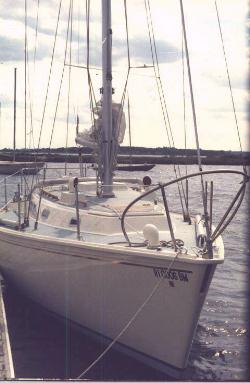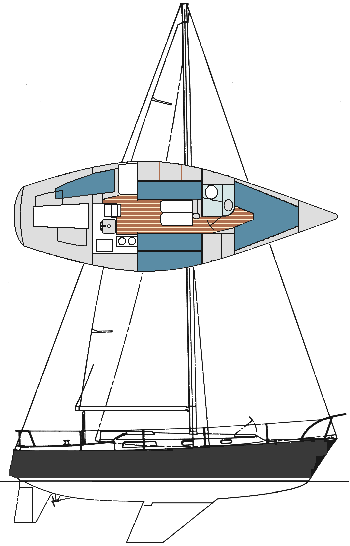The Pearson 10M
by Dan Pfeiffer
 In most ways the 10M fits nicely into the Pearson cruiser/racer approach reaching perhaps just a little closer to the racer end of the spectrum than other Pearson's of it's day. Production started in 1973 and ran until 1980 with about 236 boats produced. Peak production was in 1974 and 1975 and tapered off from there with only about a dozen boats being built in the last two years.
In most ways the 10M fits nicely into the Pearson cruiser/racer approach reaching perhaps just a little closer to the racer end of the spectrum than other Pearson's of it's day. Production started in 1973 and ran until 1980 with about 236 boats produced. Peak production was in 1974 and 1975 and tapered off from there with only about a dozen boats being built in the last two years.
DESIGN and CONSTRUCTION
The 10M has a fairly narrow entry and round-ish sections forward. Beam tapers aft but not as much as many 70's IOR influenced boats. The draft is almost 6 feet in a fin keel with 5,445 lbs of ballast. The large rudder is mounted on a skeg. There is a slight bit of reverse in the transom and very short overhangs for a mid 70's design. The waterline is on the long side at 28'4". The hull is a solid lay-up of mat and woven roving. Centerline thickness is a bit over 1" and tapers to about 3/8" at the topsides. The hull deck joint (typical of 70's and later Persons) is an outward flange that is set in sealer and bolted together on 4" centers. The flange is covered by a sturdy vinyl rubrail that can be replaced. Inside, the joint was glassed over with layers of fiberglass cloth. This is a very sturdy construction and one favored by Naval Architect David Gerr. The deck is balsa cored with plywood in some higher loaded areas. Deck hardware was sealed with silicone and the 10M can suffer from the typical delamination problems from water in a cored deck.
INTERIOR
The interior layout is fairly conventional and typical of mid 70's Pearson's. There is a large v-berth Forward with an enclosed head to port and hanging lockers to starboard as you move aft. The head has a shower and the sink is integrated into the fiberglass countertop. The main cabin has port and starboard settees with storage lockers behind to port and a pilot berth to starboard. The settees pull out to form larger berths (the port berth is even referred to as a double). There were variations with storage on both sides (no pilot berth), pilot berths on both sides (only small storage lockers below pilot berths) and at least one 10M had the pilot berth to port with storage to starboard. There is a fold down table on the main bulkhead. Aft of the settee area there is an L-shaped galley to starboard and a quarterberth to port with a good sized nav station at it's head. There is a dorade vent on the port side that feeds the head and main cabin. Many 10M's were delivered with an optional second dorade on the starboard side and a hatch over the main cabin. The only other ventilation is from the forward hatch over the v-berth and on some boats a cowl vent on the chain locker.
COCKPIT and DECK
The cockpit is just over seven feet with good backrest height. The traveler sits in a recess on a bridge deck just ahead of the helm position. There are alcove storage boxes (typical of Pearson) and a large lazarette locker. The port locker gives up a fair amount of space to the quaterberth. The starboard locker is very large but is home to the water heater and pump (on a shelf forward) and sometimes to the batteries which makes access to the engine and stuffing box (on A-4 boats) difficult. The coaming around the cockpit is wide enough to sit on and easy to step over when going forward. The side decks are wide and un-cluttered making passage to the foredeck easy. There is a molded toe rail about 1-1/2" high with a long genoa track fastened on top. Many 10M's have inboard genoa tracks that run beside the coaming, forward along the side of the cabin house. Boats with factory spinnaker gear have a track on the front of the mast and usually a track on the foredeck, a pair of secondary winches in the cockpit, and turning blocks on the rear quarters. Standard primary winches are Lewmar #43, halyard are Lewmar #8. Some 10M's were fitted with a wire reel main halyard winch.
 ENGINE and SYSTEMS
ENGINE and SYSTEMS
The engine is under the companionway and galley sink. The 10M came standard with the Atomic 4 gas engine. Diesel options were available throughout the production run starting with Farymann, then Volvo, then Westerbeake and then Volvo again and perhaps a Universal in there somewhere. Most common seems to be either the A-4 or the Volvo MD11C. The Volvo installation runs through a Walter v-drive with the engine sitting backwards. On v-drive equipped boats the propeller is about 2 feet further forward of the skeg allowing for more flexibility in propeller choice. Engine access is fair to poor. Batteries and water heaters can get in the way. Port side access is blocked by the quarterberth. Most 10M's were delivered with hot/cold pressure water and a shower.
MAST and RIGGING
The mast, made by Soundspar, is tapered with single spreaders, inline and forward lowers. The configuration of the lowers allows mast bend control with a backstay adjuster. The lowers are 9/32", uppers 5/16, headstay and backstay are 3/8". These are typical sizes for a 40 footer. Halyards may be internal or external. In the original design the main chainplates mounted to fiberglass knees located about 7" aft of the main bulkhead. This proved inadequate for the loads and Pearson issued a recall for hulls prior to about #89 for reinforcing of the knees. The design was revised around hull #102 to use an aluminum chainplate beam that transferred loads from to the chainplates to the main bulkhead (which was also beefed up). The old knees can still be a problem but several boats have been successfully retrofitted with chainplate beams like the later boats. The mast is keel stepped on a steel plate that sits in the bilge where it is often wet which creates a corrosion problem. The 10M was avaialble in a tall rig with an extra 2 feet of mast and 25 sf of added sail area. A few boats were delivered with a factory bow sprit that added about a foot to the foretriange. At least one of these was on a tall rig.
 UNDER SAIL
UNDER SAIL
With almost six feet of draft, fairly generous beam, and a balast ratio of 44% the 10M is a stiff boat. The relatively high displacement for it's length (compared to it's contemporaries) gives momentum to punch through head seas. In puffy air, allow the boat to feather up and accelerate rather than heel. The boat is well mannered in steep chop, forgiving, and predictable on any point of sail. One successful 10M racer says It may well be worth taking a spinnaker pole penalty (girth of spinnaker and LP of genoas larger). 10M PHRF ratings range from 141 to 156. The 10M tracks well and is easy to control in steep following seas. I have seen the boat running in 5-8 foot steep chop on L. Erie with 18-25 knots of wind (main & genoa). The helmsman had never sailed the boat before that day and had never driven a boat with a wheel. There was a bit of over-steering but he was able to maintain good control in these challenging conditions.
UNDER POWER
Under power the 10M moves well at about 6 knots. Engine and prop configurations have various effects on actual top speed and backing behavior. In general the 10M backs well when prop walk is accounted for and maneuvers well in tight quarters. OEM Fuel capacity was about 20 gallons in a cylindrical monel tank under the cockpit.
MARKET
10Ms are available fairly regularly with listed prices ranging from the low 20's to the mid 30's. Most of the boats are in the northeast with several in the great lakes, a few on the west coast and at least one in Alaska.
10M Specifications
LOA=33' 1/2"
Beam=11.0
Draft=5' 10"
LWL=28' 4"
Sail Area=524 SF
Displacement=12,441 lbs
Ballast=5,445 lbs
BR=44%
Mast Above LWL=48'
SA/D=15.6
D/L=245
L/B=3.0
BR=44%
 In most ways the 10M fits nicely into the Pearson cruiser/racer approach reaching perhaps just a little closer to the racer end of the spectrum than other Pearson's of it's day. Production started in 1973 and ran until 1980 with about 236 boats produced. Peak production was in 1974 and 1975 and tapered off from there with only about a dozen boats being built in the last two years.
In most ways the 10M fits nicely into the Pearson cruiser/racer approach reaching perhaps just a little closer to the racer end of the spectrum than other Pearson's of it's day. Production started in 1973 and ran until 1980 with about 236 boats produced. Peak production was in 1974 and 1975 and tapered off from there with only about a dozen boats being built in the last two years.
 ENGINE and SYSTEMS
ENGINE and SYSTEMS UNDER SAIL
UNDER SAIL